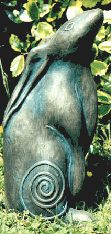By Drew Sheldrick
Note: This article was first published October 23, 2015 by National Indigenous TV (NITV), an initiative of SBS Australia. It's re-posting on The Leveret is accompanied by images from Laura House's Daily Mail article "Buns of (Blue) Steel: Indigenous Model Casey Conway Poses Up a Storm in New Campaign for Male Swimwear Designed to Combat 'Saggy Man Bum'."
Australian sport hasn't proven itself to be a bastion of racial or social harmony, especially of late. So one can only imagine the anxiety Casey Conway felt moving from Central Queensland to Sydney to play in the National Rugby League (NRL) straight out of high school.
Not only was he a small-town Aboriginal teen thrust into the spotlight in a new city, but he was leading what he calls a "double life", exploring his sexual identity in Sydney’s gay scene while keeping his relationships private from his teammates.
A Barada man, Conway grew up one of five boys in the small town of Bluff, a couple of hours west of Rockhampton. He played football from the age of six and was educated at St Brendan's College in Yeppoon – a boarding school with a specialised rugby league program well-known for producing potential NRL players. It was here he was scouted for his big break with the Sydney Roosters.
Joining the team's Jersey Flegg outfit (now known as the NRL's National Youth Competition/Holden Cup) in 2003, he was still unsure about his sexuality, before eventually admitting to club officials that he was gay.
"I was up-and-coming, so they were cautious about going about it the right way," he explained.
"They wanted to make sure I was looking after myself and accessing the support that I needed, and they were concerned about the club's image."
Despite discussing his sexuality with club management, Conway said he remained uncomfortable about the prospect of revealing he was gay to his teammates as he struggled to reconcile his rural upbringing with his new life in Sydney.
"I was out-and-about on the [gay] scene and meeting people. I was doing that undercover and it finally came to a point where I had to start accepting it. I wanted more than what I was having," he said.
If Conway was expecting a less rigid environment in which to express himself outside the world of football, he soon discovered he’d have to navigate other forms of ignorance from within the gay community.
"There was a lot of casual racism. People would say things like, 'You're hot for an Aboriginal guy' or 'I've never been with a black guy'. I'd think, 'You know that’s not a compliment?'."
Traversing worlds as a member of both racial and sexual minorities proved to be both a minefield and a unique insight into the discrimination faced by both communities.
When Anthony Mundine famously claimed that homosexuality and Aboriginal culture didn't mix, following an episode of the ABC's Redfern Now program in 2013, Conway was aghast at the thought of another Aboriginal former NRL player using his platform to preach intolerance.
"I don't think [his comments] were reflective of the Aboriginal community at all. For someone like him in a position of influence in the Aboriginal community, it was really disappointing," he said.
Now a full-time youth development coordinator for a small non-for-profit on Queensland’s Gold Coast, Conway said he sees the direct impact of those type of comments on young people coming to terms with their sexuality.
"There are young people out there hearing comments like that and they're questioning themselves. I know what it was like to be in the country and think, 'Oh shit, I think I'm gay'. At that time there wasn't really a big push in the media for equality," he said.
"I've worked with kids who are homeless because they've been kicked out of home when they came out [as gay]. They're suffering not only because they don't have a home, but because of their mental health and a raft of other issues."
Despite comments like Mundine's, Conway said he's seen a shift in the attitudes of professional athletes, even though few have chosen to reveal they’re gay themselves.
"There's not too many who have come forward, but I definitely think there's been a change. There are lots of different sporting identities, clubs and codes that are saying, 'we're for equality'. I think that’s really great. It's really positive."
Conway came out to his former teammates after he left the Sydney Roosters in 2005 – all of whom, he said, were completely supportive.
After a brief stint in the fitness industry, he became the face of Australian swimwear and underwear brand, aussieBum, breaking new ground as an Aboriginal male model on the international stage.
"It was fun, but at times a little bit overwhelming. The brand was really growing at that time. I was on giant billboards in Los Angeles and on the side of buses in London," he said.
Now the face (and body) of the Sluggers swimwear brand's summer campaign, Conway still intends to focus on his youth work after more than six years helping young people to reengage with school, employment and the community.
"Modeling is a side thing. I love my work and I’m not willing to let go of it at the moment," he said.
"I'm trying to use my more public profile as a platform to get my views out, but I also think young people appreciate that I’m now just an everyday type of guy, rather than a singer or an athlete. It helps to get those messages across."































